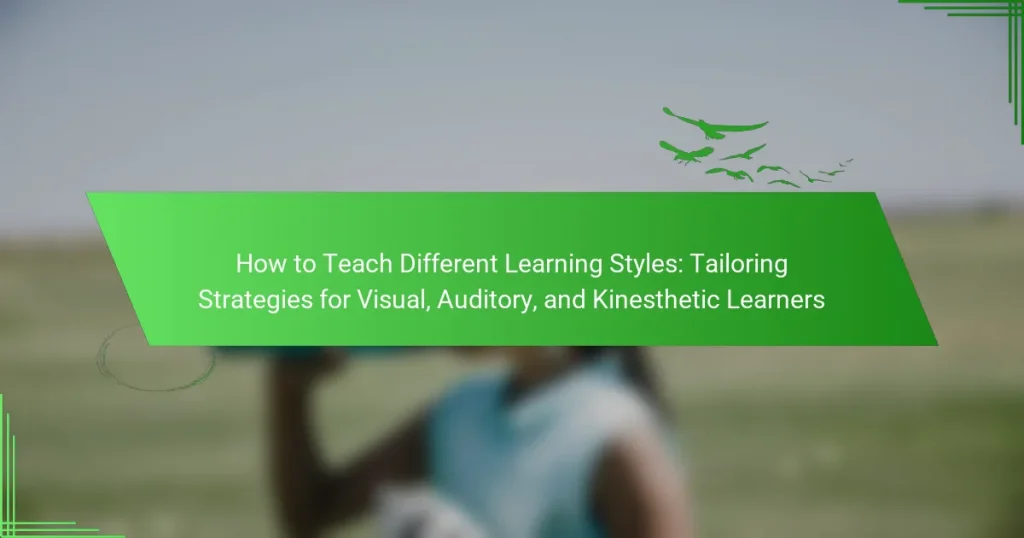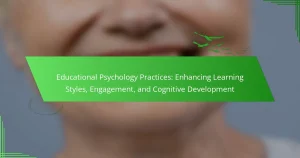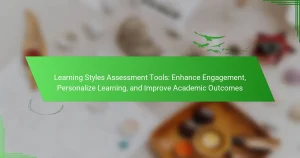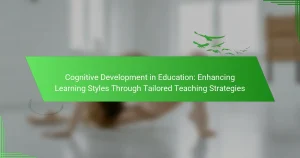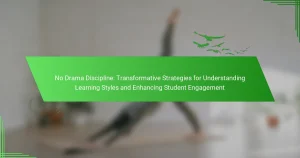Understanding different learning styles is crucial for effective teaching. Visual learners benefit from diagrams and charts, auditory learners thrive on discussions, and kinesthetic learners excel through hands-on activities. This article explores tailored strategies for each learning style, highlights best practices for engagement, and discusses common pitfalls to avoid in diverse classrooms. By implementing these approaches, educators can enhance retention and foster a more inclusive learning environment.
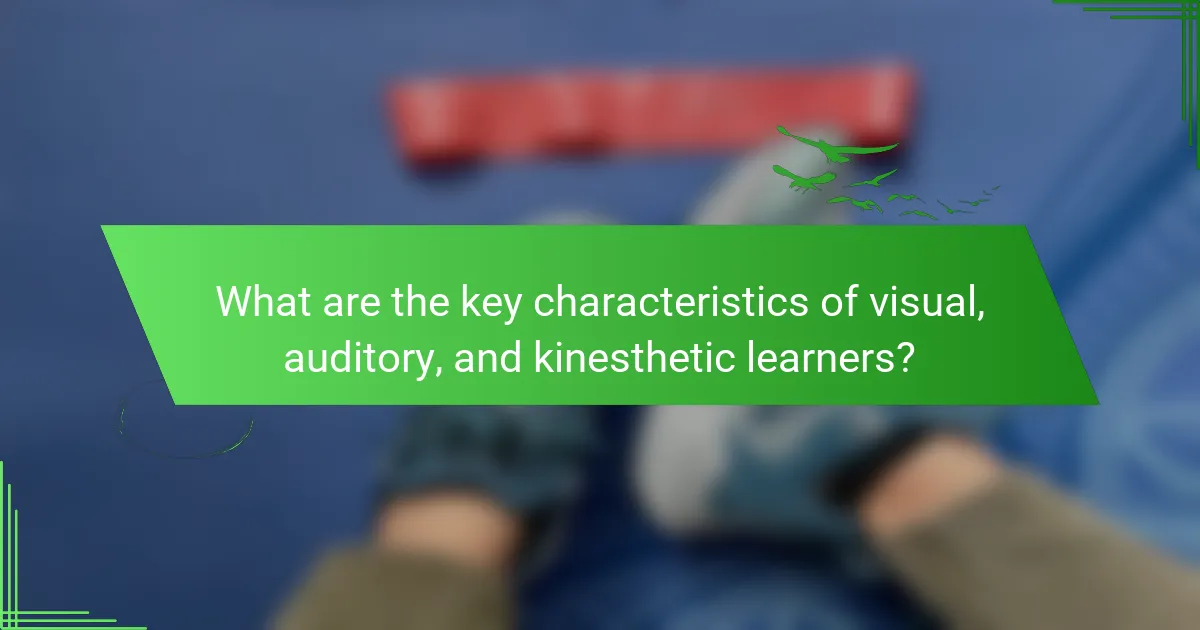
What are the key characteristics of visual, auditory, and kinesthetic learners?
Visual, auditory, and kinesthetic learners exhibit distinct characteristics that influence their learning preferences. Visual learners prefer diagrams, charts, and written instructions. Auditory learners thrive on listening to lectures and discussions. Kinesthetic learners excel through hands-on activities and movement. Understanding these traits helps tailor teaching strategies effectively for each learning style.
How do visual learners process information?
Visual learners process information through images, diagrams, and spatial understanding. They tend to retain information better when it is presented visually rather than verbally. This learning style often involves using charts, graphs, and visual aids to enhance comprehension. Visual learners benefit from color coding and organizing information visually, which helps them see relationships and patterns. Engaging visual stimuli can significantly improve their ability to grasp and recall concepts.
What strategies are effective for teaching auditory learners?
To effectively teach auditory learners, incorporate strategies that engage their listening skills. Use lectures, discussions, and audio resources to enhance comprehension. Encourage group work where verbal communication is key. Additionally, provide opportunities for auditory learners to explain concepts aloud, reinforcing their understanding through verbalization.
How can kinesthetic learners benefit from hands-on activities?
Kinesthetic learners benefit greatly from hands-on activities as these methods engage their physical senses. Such activities enhance retention and understanding by allowing learners to manipulate materials and practice skills in real-time. Engaging in tasks like experiments or role-playing fosters active participation, leading to improved outcomes. Research indicates that kinesthetic learners perform better when lessons involve movement, reinforcing the connection between physical activity and cognitive processing.
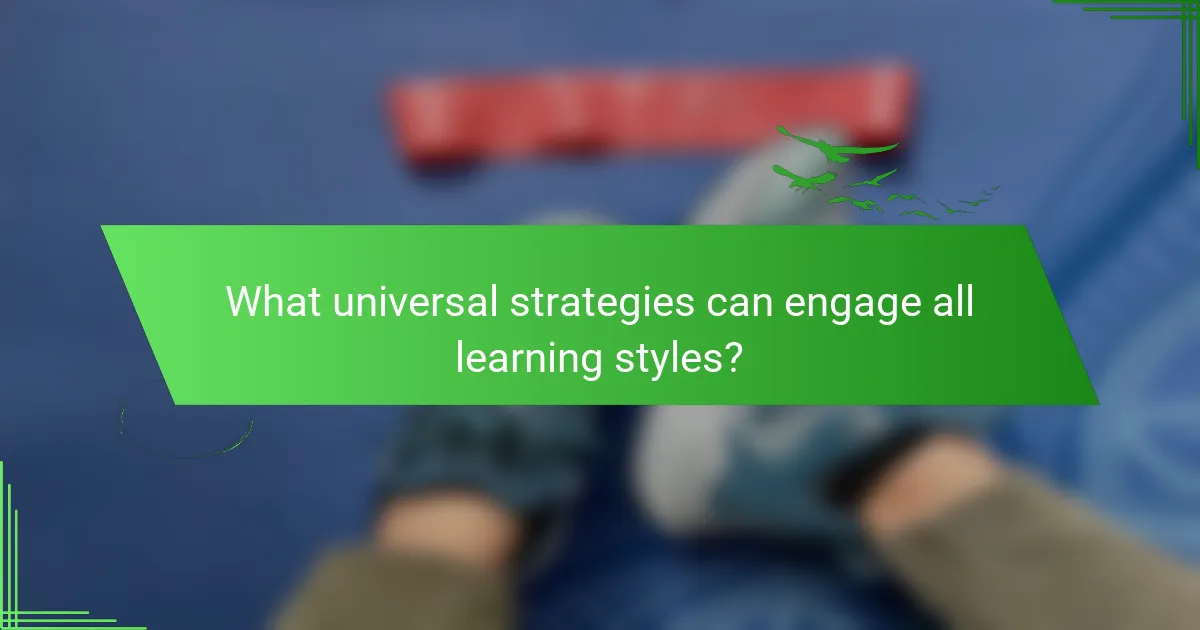
What universal strategies can engage all learning styles?
To engage all learning styles, use a combination of visual, auditory, and kinesthetic strategies. Visual learners benefit from diagrams and charts, auditory learners thrive on discussions and lectures, while kinesthetic learners excel through hands-on activities. Implementing a mix of these strategies ensures inclusivity and maximizes understanding. For example, incorporating videos alongside group discussions and interactive projects caters to diverse preferences, enhancing overall engagement and retention.
How can multimedia resources enhance learning for different styles?
Multimedia resources enhance learning by catering to various learning styles, improving engagement and retention. Visual learners benefit from videos and infographics, auditory learners thrive with podcasts and discussions, while kinesthetic learners excel through interactive simulations and hands-on activities. Each resource aligns with distinct attributes of learning styles, ensuring a tailored educational experience.
What role does collaboration play in accommodating various learners?
Collaboration enhances the teaching of different learning styles by fostering an inclusive environment. It allows educators to share strategies that cater to visual, auditory, and kinesthetic learners. For example, group activities enable students to engage with diverse materials, reinforcing their preferred learning methods. Collaborative approaches also encourage peer support, helping learners benefit from each other’s strengths. As a result, students develop a deeper understanding and retention of concepts.

What unique approaches can be tailored for each learning style?
Tailoring unique approaches for each learning style enhances educational effectiveness. Visual learners benefit from diagrams and charts, while auditory learners excel with discussions and podcasts. Kinesthetic learners thrive through hands-on activities and role-playing. Integrating these methods fosters engagement and retention across diverse learning preferences.
How can visual aids be optimally designed for visual learners?
Visual aids for visual learners should be designed with clarity and engagement in mind. Utilize vibrant colors, clear images, and organized layouts to enhance understanding. Incorporate infographics and diagrams to simplify complex information. Ensure text is concise and legible, avoiding clutter. Use consistent visual themes to create familiarity and aid retention.
What auditory techniques can improve retention for auditory learners?
Auditory learners can enhance retention through techniques like active listening, verbal repetition, and auditory summarization. Active listening involves fully concentrating on spoken information, which aids memory. Verbal repetition reinforces learning by repeating key concepts aloud. Auditory summarization encourages learners to articulate their understanding, further solidifying knowledge. These strategies leverage auditory processing strengths to improve retention effectively.
How can movement and physical engagement be integrated for kinesthetic learners?
Integrating movement and physical engagement enhances learning for kinesthetic learners. Activities like role-playing, hands-on experiments, and movement-based games facilitate retention and understanding. Incorporating structured breaks for physical activity can also improve focus and information absorption.
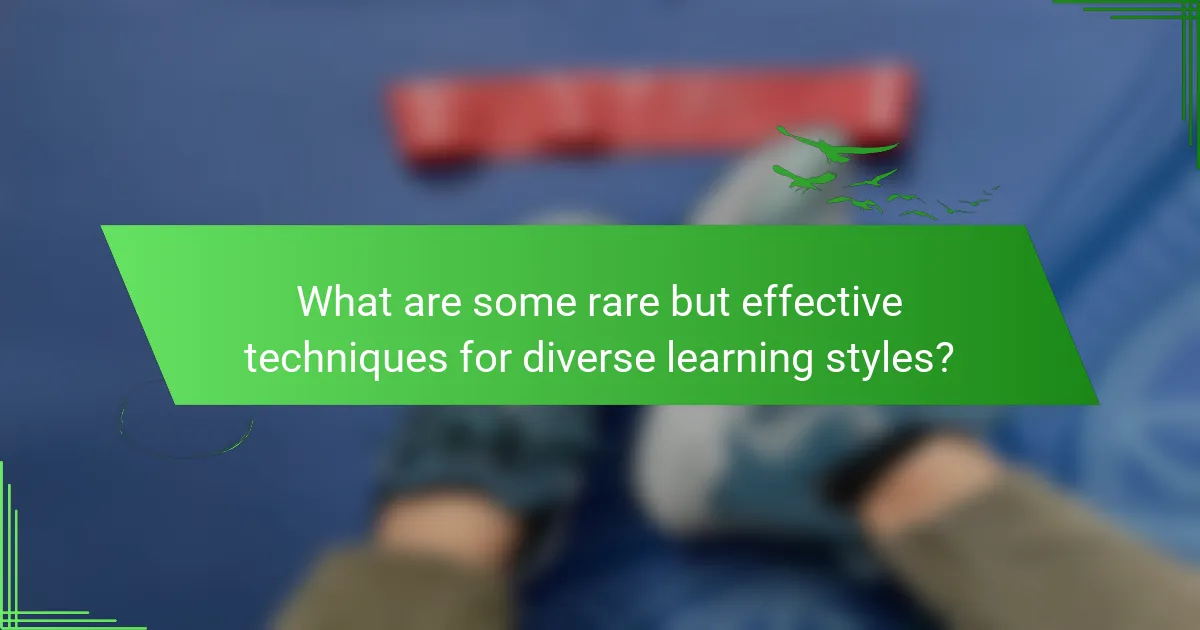
What are some rare but effective techniques for diverse learning styles?
Incorporating rare techniques for diverse learning styles can enhance engagement and retention. One effective method is using storytelling to convey information, which benefits visual and auditory learners. Another technique is incorporating movement into lessons, appealing to kinesthetic learners. Mind mapping can also be a unique strategy, allowing all learning styles to visualize connections between concepts. Finally, utilizing gamification can motivate and engage learners across all styles, making learning interactive and enjoyable.
How can storytelling be used to teach different learning styles?
Storytelling effectively engages different learning styles by creating relatable narratives. Visual learners benefit from imagery and diagrams within stories. Auditory learners grasp concepts through spoken word and sound effects. Kinesthetic learners connect through interactive storytelling experiences, such as role-playing. Each method enhances retention and understanding by aligning with learners’ unique processing preferences.
What unconventional methods can support kinesthetic learning in traditional settings?
Unconventional methods that support kinesthetic learning in traditional settings include hands-on activities, role-playing, and movement-based learning. These approaches engage learners physically, enhancing retention and understanding. Incorporating tools like manipulatives or interactive technology can further facilitate active participation. As a result, kinesthetic learners thrive in environments that encourage exploration and physical interaction.
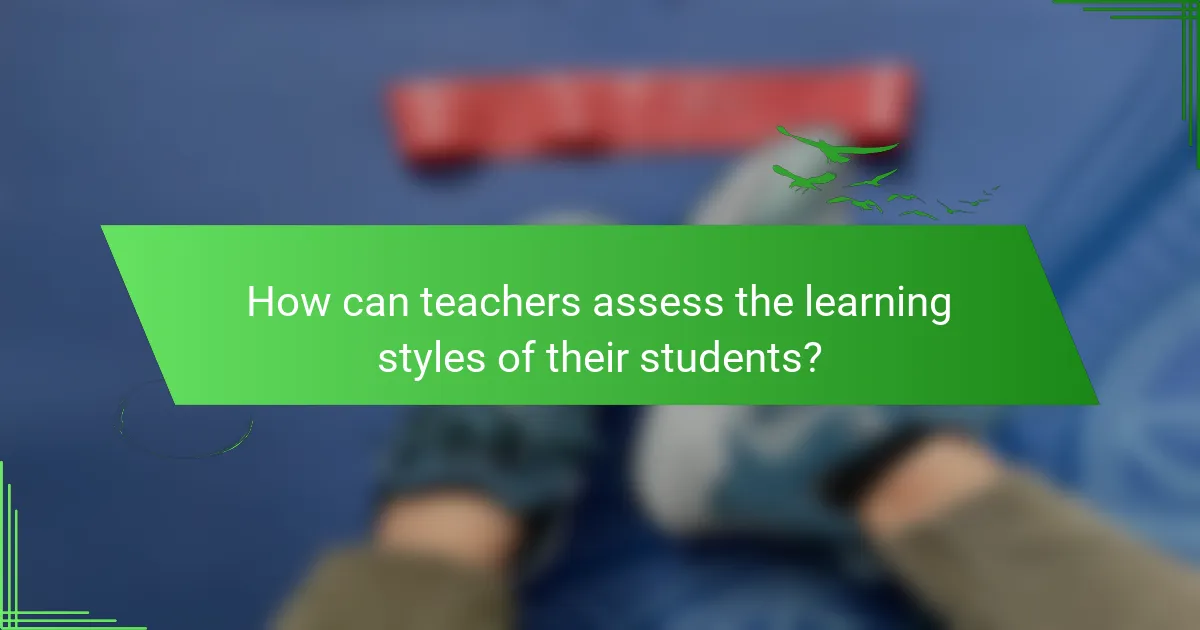
How can teachers assess the learning styles of their students?
Teachers can assess students’ learning styles through observation, surveys, and tailored activities. Observing student engagement during different instructional methods helps identify preferences. Surveys can provide insights into individual learning preferences. Additionally, implementing varied instructional strategies allows teachers to see which methods yield the best student responses.
What tools or assessments are available for identifying learning styles?
Various tools and assessments are available to identify learning styles, including questionnaires, observational assessments, and learning style inventories. These tools help educators tailor their teaching strategies effectively.
Questionnaires like the VARK questionnaire assess preferences for visual, auditory, reading/writing, and kinesthetic learning. Observational assessments allow teachers to identify how students engage with material in real-time. Learning style inventories, such as the Gardner’s Multiple Intelligences assessment, categorize students based on their strengths and preferences.
Using these tools enhances teaching effectiveness by aligning instructional methods with students’ unique learning styles.
How can feedback be structured to support different learners?
Feedback can be structured to support different learners by aligning it with their specific learning styles. Visual learners benefit from graphical feedback, while auditory learners thrive on verbal explanations. Kinesthetic learners require hands-on feedback through practical demonstrations. Tailoring feedback to these styles enhances understanding and retention. For example, using charts for visual learners, discussions for auditory learners, and interactive activities for kinesthetic learners can significantly improve learning outcomes.
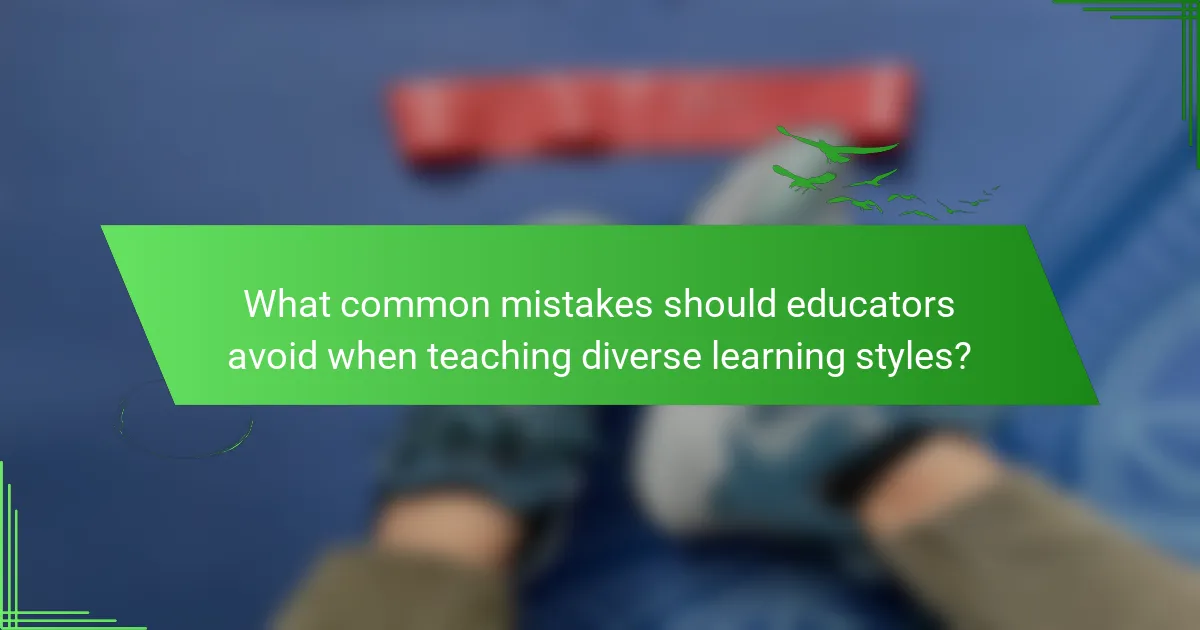
What common mistakes should educators avoid when teaching diverse learning styles?
Educators should avoid several common mistakes when teaching diverse learning styles. Failing to recognize individual learning preferences can hinder student engagement. Using a one-size-fits-all approach often neglects the unique needs of visual, auditory, and kinesthetic learners. Overloading students with information without incorporating varied teaching methods may lead to frustration and disengagement. Additionally, not providing opportunities for hands-on experiences can limit kinesthetic learners’ understanding. Lastly, neglecting to solicit feedback from students prevents educators from adjusting their strategies effectively.
How can overgeneralizing learning styles hinder student progress?
Overgeneralizing learning styles can significantly hinder student progress by limiting personalized teaching approaches. When educators apply a one-size-fits-all method, they neglect the unique attributes of individual learners, such as their preferred modalities. This can lead to disengagement and a lack of motivation, as students may not connect with the material presented. Additionally, research shows that tailoring strategies to specific learning styles can enhance retention and understanding, making it essential to recognize and adapt to diverse learning needs.
What pitfalls exist in not adapting teaching methods to learning preferences?
Failing to adapt teaching methods to learning preferences can hinder student engagement and comprehension. When educators ignore individual learning styles, they risk creating a one-size-fits-all approach that alienates students. This can lead to decreased motivation, lower academic performance, and increased frustration among learners. Visual, auditory, and kinesthetic learners may struggle to grasp concepts effectively if teaching methods do not align with their preferred styles. As a result, students may disengage from the learning process, leading to a lack of retention and understanding of the material. Tailoring strategies to accommodate various learning preferences enhances overall educational outcomes.
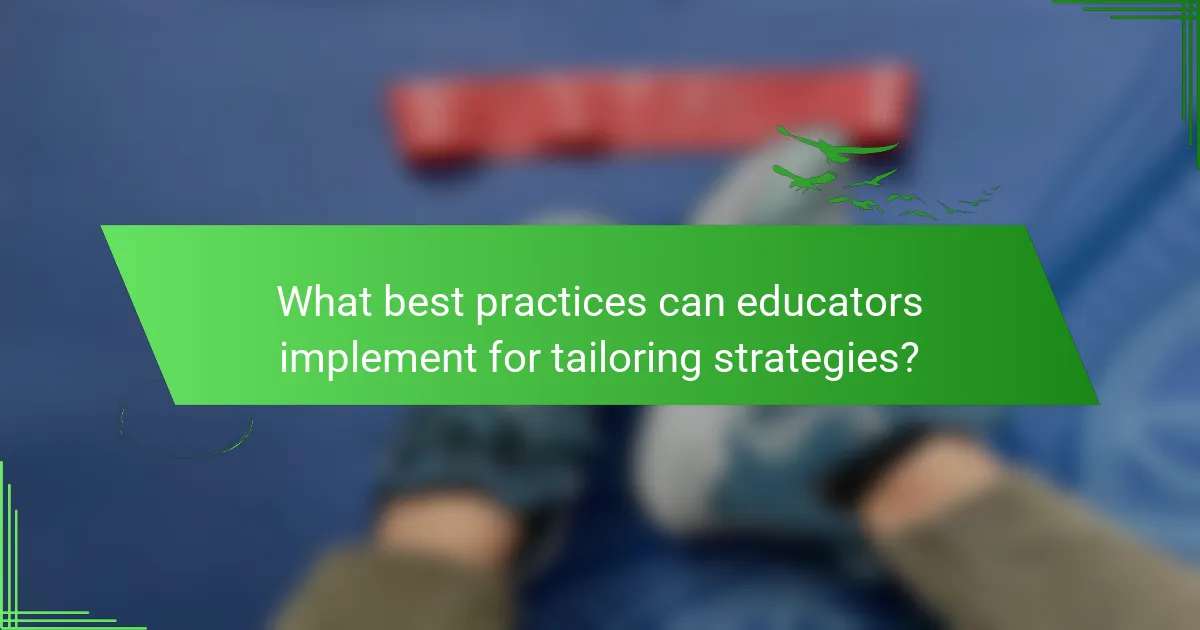
What best practices can educators implement for tailoring strategies?
Educators can implement best practices by using differentiated instruction tailored to visual, auditory, and kinesthetic learners. Incorporating visual aids, such as charts and diagrams, benefits visual learners. Auditory learners thrive on discussions and lectures, while kinesthetic learners engage best through hands-on activities. Regular assessments can help educators adapt their strategies to meet diverse learning needs effectively.
How can lesson plans be designed to incorporate multiple learning styles?
Incorporating multiple learning styles in lesson plans requires tailored strategies for each type of learner. Visual learners benefit from diagrams and videos, while auditory learners thrive on discussions and lectures. Kinesthetic learners engage better with hands-on activities.
To effectively design lesson plans, start by identifying the learning styles of your students. Integrate various teaching methods to address all styles, ensuring content is accessible. For example, combine visual aids with group discussions and interactive tasks. This approach fosters an inclusive learning environment, enhancing student engagement and retention.
Regularly assess the effectiveness of your strategies through feedback and adapt as needed. By doing so, you ensure all students can connect with the material, maximizing their learning potential.
What ongoing professional development can support teachers in this area?
Ongoing professional development for teachers can include workshops on differentiated instruction, online courses focusing on learning styles, and peer collaboration sessions. These opportunities enhance teaching strategies tailored for visual, auditory, and kinesthetic learners. Research indicates that effective training improves student engagement and learning outcomes. For example, teachers who participate in specialized training report a 30% increase in student performance.
